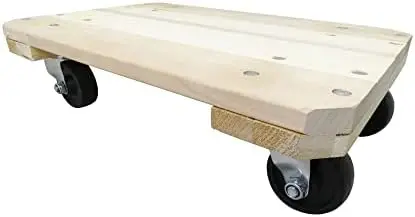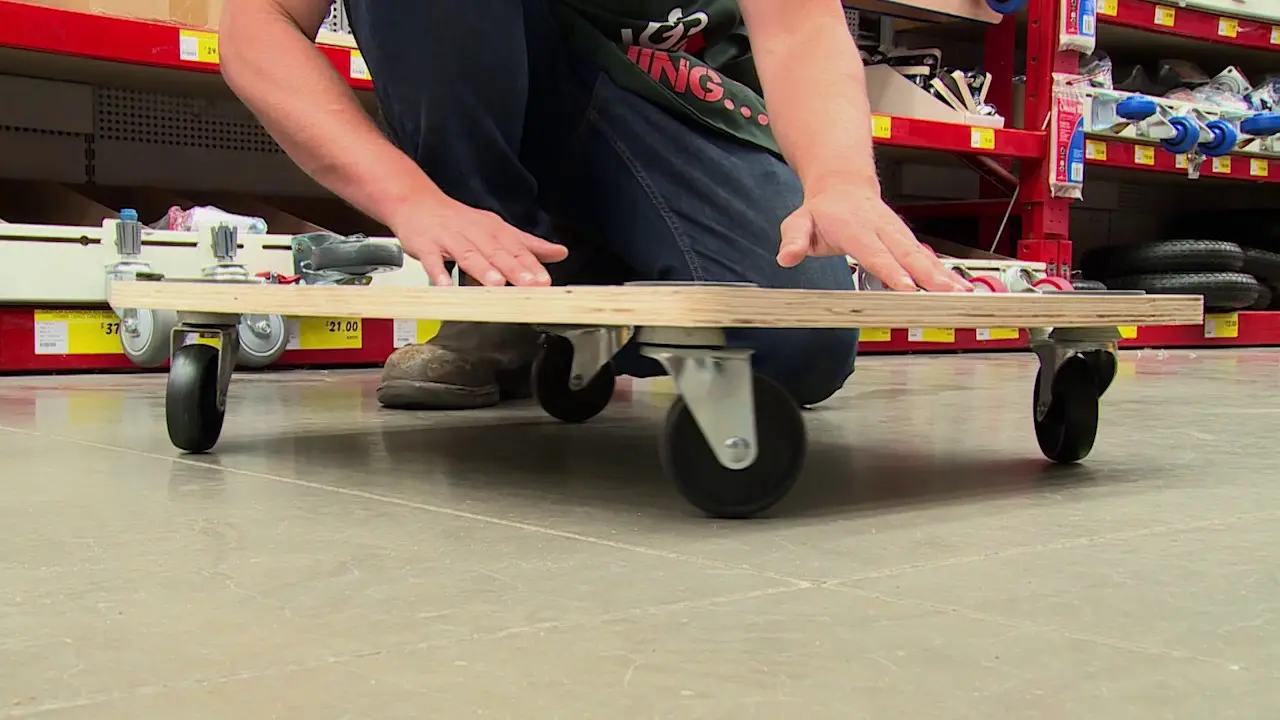Why Are Furniture Dolly’s Loud? If you’ve ever moved furniture, you’ve likely encountered a furniture dolly. These handy tools make it easier to transport heavy items, but there’s one thing everyone notices: the noise. Furniture dollys can be surprisingly loud, whether you’re moving across hardwood floors, tiles, or even concrete. But why are they so noisy, and what can be done about it?
In this article, we’ll explore the reasons behind the loudness of furniture dollys, what factors contribute to their noise, and practical solutions for quieter moves. We’ll also look at how the design, materials, and environments affect the noise levels and whether quieter alternatives exist. Let’s dive in.

The Anatomy of a Furniture Dolly
To understand why furniture dollys are loud, it’s essential to know what they are made of and how they work. A furniture dolly typically consists of:
- A platform: Often made from wood, steel, or plastic, this is the flat base where the furniture sits.
- Wheels or casters: Usually four wheels (sometimes more) are attached to the underside of the platform. These are responsible for most of the movement—and the noise.
- Frame or base: This provides the structural support to hold the weight of the furniture.
Types of Dolly Wheels
The wheels of a furniture dolly are key to understanding the noise. There are several common types:
- Hard plastic wheels: These are some of the noisiest because they have little cushioning and tend to amplify vibrations as they move.
- Rubber wheels: Quieter than plastic wheels, rubber absorbs some of the impact with the ground but can still generate noise, especially on rough surfaces.
- Metal casters: These can be extremely loud, particularly on hard surfaces like concrete or tile. They offer little sound dampening and can create a jarring noise when in use.
Why Wheels Create Noise
Noise from furniture dollys primarily comes from the wheels interacting with the floor. Several factors contribute to this:
- Vibration: As the wheels move, they vibrate against the surface. Harder surfaces create more noise because there’s less cushioning to absorb the vibrations.
- Wheel material: Harder materials, like plastic or metal, transfer more sound than softer materials, like rubber.
- Friction: The friction between the wheels and the floor also produces sound. Rough surfaces like concrete or tile create more friction, and therefore more noise.
- Weight: The heavier the item on the dolly, the more pressure is put on the wheels, increasing the noise. Heavy furniture causes the wheels to press harder into the ground, making any vibrations or friction louder.
Flooring and Noise: The Relationship
Different flooring types can make a significant difference in how loud a furniture dolly is. Here’s a breakdown of how common flooring materials interact with dolly wheels:
Hardwood Floors
Hardwood floors can amplify the noise of a furniture dolly because the wheels often vibrate against the hard surface. Depending on the wood, you may also hear a loud clunk when the dolly rolls over small bumps or imperfections in the floor.
Tile Floors
Tile floors tend to echo, making the noise from dolly wheels even louder. Additionally, the grout lines between tiles can cause a jarring noise as the wheels move over them, particularly if they are hard plastic or metal wheels.
Concrete Floors
Concrete is a hard surface that provides little sound absorption. Metal or plastic wheels on concrete can create a lot of noise, especially in an open space where sound bounces off the walls. If you’re moving furniture in a garage or basement, expect the dolly to be loud.
Carpet
Carpeted floors, on the other hand, help to reduce the noise. The soft material absorbs some of the sound and prevents the wheels from creating as much friction. However, thick carpets can make it harder to move the dolly smoothly, which may result in a different type of noise—like straining or dragging.
Furniture Dollys: Why Are Furniture Dolly’s loud?
Design Factors That Impact Noise
Aside from the wheel material and floor type, the design of the furniture dolly also influences how noisy it is. Some key design factors include:
Wheel Size
Larger wheels tend to roll more smoothly over surfaces, reducing the noise. Smaller wheels, especially those made of hard materials, are more likely to get caught on small obstacles or cracks in the floor, causing a louder sound.
Bearings
High-quality ball bearings in the wheels can reduce friction, leading to a quieter operation. Cheaper dollys may have poorly lubricated or low-quality bearings, which can cause squeaking or grinding noises as they move.
Frame Construction
A solid, well-built frame can also reduce noise. A wobbly or poorly assembled dolly may creak and rattle as it moves, adding to the overall sound. Some dollys have padded platforms, which can help absorb some vibrations, especially when moving on hard surfaces.

The Role of Weight and Load Distribution
The amount of weight placed on a dolly also plays a crucial role in noise levels. Heavier loads increase the pressure on the wheels, which in turn can amplify sound. Additionally, if the load is not evenly distributed, it can cause the dolly to tip slightly or wobble, creating extra noise as the wheels fight to maintain balance.
For example, if you’re moving a large, heavy piece of furniture like a refrigerator, and it’s off-centre on the dolly, you’ll likely hear more noise as the dolly struggles to stay stable.
Practical Solutions for a Quieter Dolly
Now that we’ve identified the main reasons why furniture dollys can be loud, let’s look at some practical solutions to reduce the noise:
Use Rubber Wheels
If noise is a concern, opting for a dolly with rubber wheels is one of the best solutions. Rubber helps to cushion the movement and absorb some of the vibrations that cause noise. While rubber wheels can still be loud on very rough surfaces, they are generally much quieter than plastic or metal options.
Add Padding
You can also add padding to your dolly, particularly around the frame or platform, to reduce the impact noise. For instance, foam padding on the bottom of the platform can help soften the contact between the dolly and the floor.
Maintain the Dolly
A well-maintained dolly is quieter than one with worn-out parts. Make sure to lubricate the wheels and bearings regularly to prevent squeaking or grinding sounds. Check the wheels for any cracks or damage that could make them louder during use.
Choose the Right Dolly for the Job
Not all dollys are created equal. For quieter moves, consider investing in a higher-quality dolly with larger, softer wheels and a well-built frame. Some dollys are specifically designed for indoor use and come with sound-reducing features.
Use Floor Mats or Blankets
If you’re moving furniture across hard surfaces like tile or wood, placing floor mats or blankets underneath the dolly’s path can significantly reduce the noise. This not only helps to cushion the sound but also protects your floors from scratches.
Move Slowly and Evenly
Another simple way to reduce noise is to move the dolly slowly and avoid sudden jerks or movements. Fast, abrupt movements can increase vibrations and make the dolly louder. Maintaining a steady, even pace can help minimize the sound.
People also serch Warframe Why Are The Keybinds For Durivi Weird
Quieter Alternatives to Traditional Dollys
If you’re still concerned about noise, there are quieter alternatives to traditional furniture dollys:
Air-Powered Moving Systems
Air-powered moving systems use a cushion of air to lift and move heavy furniture. While they’re much quieter than wheeled dollys, they are also more expensive and require a flat surface to work effectively.
Furniture Sliders
For short moves or repositioning furniture within a room, furniture sliders can be a great option. These small pads are placed under furniture legs and allow you to slide the piece across the floor without the need for wheels, significantly reducing noise.
Conclusion
Furniture dollys are loud for a variety of reasons, from the material of the wheels to the type of floor you’re moving across. Hard plastic or metal wheels on hard surfaces tend to produce the most noise due to vibrations, friction, and weight distribution. However, by understanding these factors and making small adjustments like choosing rubber wheels, adding padding, or using floor mats you can make the moving process much quieter.
If noise is a significant concern, it may be worth investing in a higher-quality dolly or considering alternative moving solutions like air-powered systems or furniture sliders. Whether you’re moving house or rearranging your living room, a quieter dolly can make the process smoother and far less noisy.





